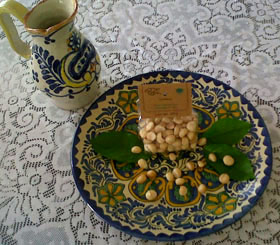Mexican Kitchen

A recent trip to the cloud covered village of Cuetzalan, high in the Sierra of Puebla, generated more of the questions that arise on each visit. How does the regional dress of pure white cotton, worn daily, stay so clean in a place where it rains nearly every day? How do any vehicles get to the center of town when most of the cobblestone streets are stairways rather than roads? And how is it that some of the most remote farms in Mexico are growing one of the world’s most expensive luxury foods?
The answer to the last question lies in the rolling fog that gives the town an appealingly mystical quality, while at the same time making it difficult to stay dry. For it turns out that macadamias — the priciest nuts in the world — thrive in the same mountain mist that is so good for growing coffee, another important crop in the Sierra.
In the world of nuts, macadamias are the gold standard, costing more than 30 dollars per kilo. These Australian natives, consumed by the aborigines before the arrival of Europeans, are generally associated with Hawaii and commonly sold as souvenirs and gifts from the islands. However, commercial cultivation of macadamias did not begin there until the 1930s, and started in California in the 1950s. The nuts are also grown in parts of Africa, Central and South America. In comparison, Mexico was a latecomer to the macadamia business.
In 1999, the state government of Puebla gave grant money to farmers in the Sierra Norte region for the planting and cultivation of macadamias, which are also grown, to a lesser extent, in Michoacan and Veracruz. The trees flourished, but the grant money ended. While some of the farmers were able to continue cultivation and distribution, others were not, and today sell mostly to neighbors. Even without cultivation, the hearty macadamia trees, which are highly resistant to root rot and insect damage, continue to produce nuts.
One of the Sierra’s growing number of non-profit organizations, El Vivero Macadamia, recently bought grafted seedlings from farmers who cannot afford the costs of cultivation, and planted an orchard of 150 trees, which will start to produce nuts in three more years. Meanwhile, the group is buying nuts from the poorer farmers and teaching local women, many of whose husbands have gone north, to make macadamia truffles, cookies, garapiñadas (candied nuts) roasted and salted nuts and, because this is Mexico, macadamias enchiladas (chile coated nuts.) The goal is to create self sustaining cooperatives to cultivate the nuts and produce these products.
Although the young trees will produce in three years, they will not begin to yield large commercial quantities for seven years, and usually bear fruit for 100 years or longer. Perhaps because these evergreens are so sturdy, the nuts have dauntingly hard shells that must be removed by crushing between steel rollers after the husks have been removed and the nuts left to dry in order to remove some of their moisture.
The two edible varieties of macadamia nuts, integrifolia and tetraphylla, both have significant nutritional value. Macadamias have the highest amount of beneficial monounsaturated fat of any nut, making macadamia oil as acceptable as olive oil in the diet. The nuts contain 9% protein and are a good source of iron, calcium, phosphorus and Vitamin B1.
Macadamias are sold in Mexican supermarkets and the sweets made from them, especially the cookies, are found in many health and gourmet stores. They can also be used in certain savory dishes, such as the trout in macadamia crust prepared at the trout farm restaurant at the edge of the National Park in Uruapan, and in the creamy macadamia sauce that has become part of Michoacan’s regional cuisine.
Macadamia oil is prized as an ingredient in skin care products and for use in gourmet kitchens. Chefs recommend it for salads and fish dishes. It can also be infused with chile, garlic or herbs.
Unshelled nuts are considerably cheaper, but not recommended unless you have a lot of patience or a pet macaw to crack the shells. For a special meal or dessert, macadamias are worth the splurge, and the following recipes present some ways of using them.
- Shrimp with macadamia cilantro pesto: Camarones con pesto de macadamia y cilantro
- Trout in Mexican macadamia sauce: Trucha en macadamia
- Macadamia peach salsa: Salsa de macadamia y durazno
- Macadamia truffles: Truffles de macadamia

